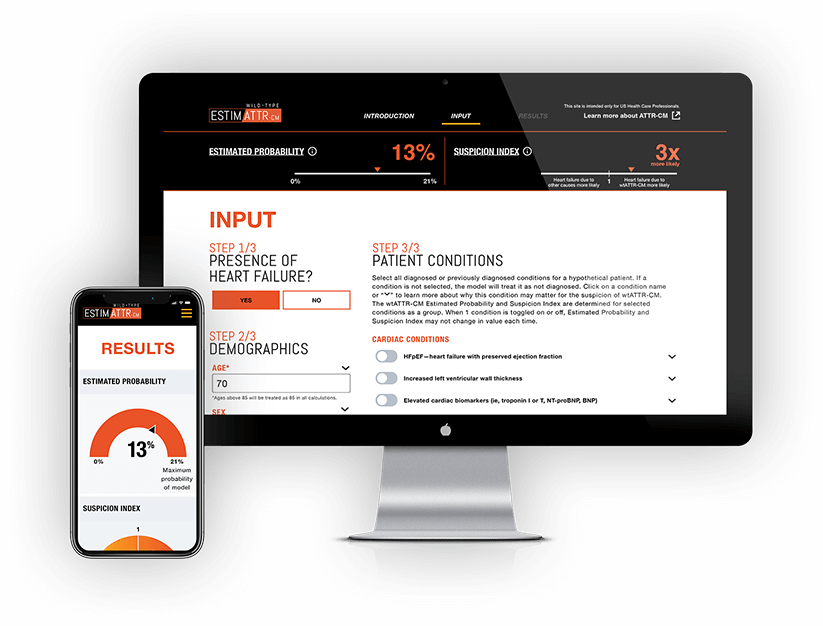UNDERSTANDING
WHAT IS
wtATTR IS THOUGHT TO ACCOUNT FOR THE MAJORITY OF

PATIENT CONSIDERATIONS
- Predominantly affects older, Caucasian men3,5-7
- Symptom onset typically over the age of 60 years5
Common characteristics that may present in
- Heart failure3,6,7
- Cardiac arrhythmias, particularly atrial fibrillation3,6-8
- History of orthopedic manifestations, such as bilateral carpal tunnel syndrome, lumbar spinal stenosis, and/or biceps tendon rupture9-11
PROGNOSIS
Once diagnosed, untreated patients have a median survival of ~3.5 years.3,7,12
PARTICULARLY HEART FAILURE WITH PRESERVED EJECTION FRACTION (HFpEF)13,14
In 2 studies, wtATTR deposits were identified in the hearts of 10% to 13% of older patients with HFpEF, respectively13,14:
- In a US study of 108 patients referred to a dedicated center, ~10% had ATTR-CM confirmed by endomyocardial biopsy (EMB)13*
- In an ex-US study conducted in 120 HFpEF patients 60 years or older, wtATTR was confirmed in 13% (13.3%; 95% CI: 7.2-19.5) of the patients14†
*A prospective analysis in 108 patients (61% women, age range: 57-74 years) seen at the Johns Hopkins University HFpEF Clinic who underwent endomyocardial biopsy to evaluate myocardial tissue histopathology.13
†A prospective, cross-sectional, single-center study at a tertiary university hospital in Madrid, Spain. Included 120 patients ≥60 years of age (59% women, mean age: 82 ± 8 years) admitted for HFpEF, with LV ejection fraction ≥50% and LV hypertrophy ≥12 mm. 99mtechnetium-labeled 3,3-diphosphono-1,2-propanodicarboxylic acid (99mTc-DPD) scintigraphy used to confirm
wtATTR, wild-type transthyretin amyloid fibril protein.

USE THE estimATTR TO LEARN ABOUT CLINICAL CONDITIONS COMMONLY ASSOCIATED WITH wtATTR-CM
利用 estimATTR,了解 wtATTR-CM 常見的相關臨床症狀
A PROBABILITY ESTIMATOR FOR wtATTR-CM
This tool is only to be used by Taiwan health care professionals. It is for educational purposes only, and is not to be used for the suspicion or diagnosis of wtATTR-CM in individual patients in a clinical setting.

The
Using hypothetical patient cases presenting with heart failure, the estimATTR can highlight the types of combinations of cardiac and noncardiac conditions that should raise suspicion for
- Estimating the probability of
wtATTR-CM based on combinations of clinical features known to be associated with the disease - Illustrating important features that help distinguish between
wtATTR-CM and heart failure from other causes
References: 1. Ruberg FL, Grogan M, Hanna M, Kelly JW, Maurer MS. Transthyretin amyloid cardiomyopathy: JACC state-of-the-art review. J Am Coll Cardiol. 2019;73(22):2872-2891. 2. Witteles RM, Bokhari S, Damy T, et al. Screening for transthyretin amyloid cardiomyopathy in everyday practice. JACC Heart Fail. 2019;7(8):709-716. 3. Connors LH, Sam F, Skinner M, et al. Heart failure resulting from age-related cardiac amyloid disease associated with wild-type transthyretin: a prospective, observational cohort study. Circulation. 2016;133(3):282-290. 4. Benson MD, Buxbaum JN, Eisenberg DS, et al. Amyloid nomenclature 2018: recommendations by the International Society of Amyloidosis (ISA) nomenclature committee. Amyloid. 2018;25(4):215-219. 5. Ruberg FL, Berk JL. Transthyretin (TTR) cardiac amyloidosis. Circulation. 2012;126(10):1286-1300. 6. Maurer MS, Hanna M, Grogan M, et al. Genotype and phenotype of transthyretin cardiac amyloidosis: THAOS (Transthyretin Amyloid Outcome Survey). J Am Coll Cardiol. 2016;68(2):161-172. 7. Pinney JH, Whelan CJ, Petrie A, et al. Senile systemic amyloidosis: clinical features at presentation and outcome. J Am Heart Assoc. 2013;2(2):e000098. 8. Maurer MS, Elliott P, Comenzo R, Semigran M, Rapezzi C. Addressing common questions encountered in the diagnosis and management of cardiac amyloidosis. Circulation. 2017;135(14):1357-1377. 9. Nakagawa M, Sekijima Y, Yazaki M, et al. Carpal tunnel syndrome: a common initial symptom of systemic wild-type ATTR (ATTRwt) amyloidosis. Amyloid. 2016;23(1):58-63. 10. Westermark P, Westermark GT, Suhr OB, Berg S. Transthyretin-derived amyloidosis: probably a common cause of lumbar spinal stenosis. Ups J Med Sci. 2014;119(3):223-228. 11. Geller HI, Singh A, Alexander KM, et al. Association between ruptured distal biceps tendon and wild-type transthyretin cardiac amyloidosis. JAMA. 2017;318(10):962-963. 12. Grogan M, Scott CG, Kyle RA, et al. Natural history of wild-type transthyretin cardiac amyloidosis and risk stratification using a novel staging system. J Am Coll Cardiol. 2016;68:1014-1020. 13. Hahn VS, Yanek LR, Vaishnav J, et al. Endomyocardial biopsy characterization of heart failure with preserved ejection fraction and prevalence of cardiac amyloidosis. JACC Heart Fail. 2020;8(9):712-724. doi:10.1016/j.jchf.2020.04.007 14. González-López E, Gallego-Delgado M, Guzzo-Merello G, et al. Wild-type transthyretin amyloidosis as a cause of heart failure with preserved ejection fraction. Eur Heart J. 2015;36(38):2585-2594.

